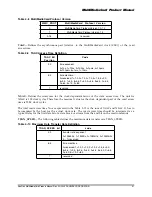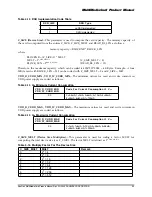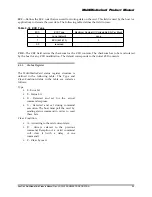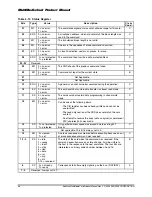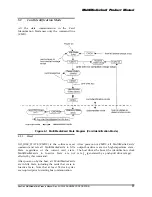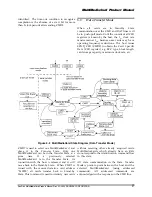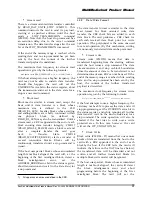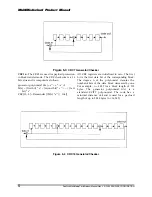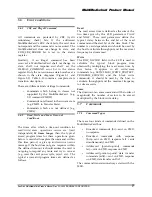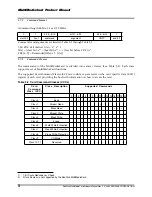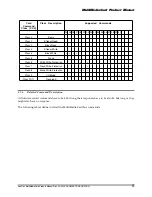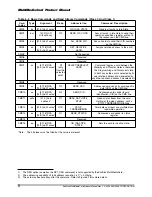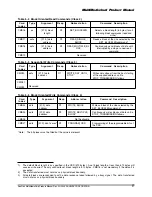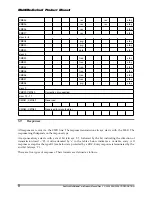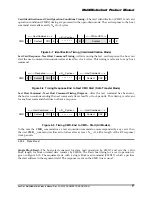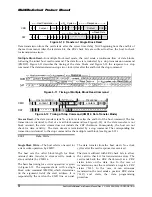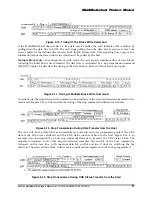
MultiMediaCard Product Manual
SanDisk MultiMediaCard Product Manual Rev. 2 © 2000 SANDISK CORPORATION
45
The SEND_WRITE_PROT command is similar to
a single block read command. The card will send a
data block containing 32 write protection bits
(representing 32 write protect groups starting a t
the specified address) followed by 16 CRC bits.
The address field in the write protect commands is
a group address in byte units. The card will ignore
all LSBs below the group size.
5.4
Clock Control
The MultiMediaCard bus clock signal can be used
by the MultiMediaCard host to set the cards to
energy saving mode or to control the data flow (to
avoid under-run or over-run conditions) on the bus.
The host is allowed to lower the clock frequency or
shut it down.
There are a few restrictions the MultiMediaCard
host must follow:
•
The bus frequency can be changed at any
time (under the restrictions of maximum
data transfer frequency, defined by the
MultiMediaCard and the identification
frequency).
•
It is an obvious requirement that the clock
must be running for the MultiMediaCard
to output data or response tokens. After
the last MultiMediaCard bus transaction,
the host is required, to provide
8 (eight)
clock cycles for the card to complete the
operation before shutting down the clock.
Following is a list of various
MultiMediaCard bus transactions:
•
A command with no response. 8 clocks
after the host command end bit.
•
A command with response. 8 clocks after
the card response end bit.
•
A read data transaction. 8 clocks after the
end bit of the last data block.
•
A write data transaction. 8 clocks after
the CRC status token.
•
The host is allowed to shut down the clock
of a “busy” card. The MultiMediaCard
will complete the programming operation
regardless of the host clock. However, the
host must provide a clock edge for the card
to turn off its busy signal. Without a clock
edge
the MultiMediaCard (unless
previously disconnected by a deselect
command -CMD7) will force the DAT line
down, permanently.
5.5
Cyclic Redundancy Codes (CRC)
The
CRC is intended for protecting
MultiMediaCard commands, responses and data
transfer against transmission errors on the
MultiMediaCard bus. One CRC is generated for
every command and checked for every response on
the CMD line. For data blocks, one CRC per
transferred block is generated. The CRC is
generated and checked as described in the
following.
CRC7
—The CRC7 check is used for all commands,
for all responses except type R3, and for the CSD
and CID registers. The CRC7 is a 7 bit value and is
computed as follows:
generator polynomial: G(x) = x
7
+ x
3
+ 1.
M(x) = (first bit) * x
n
+ (second bit) * x
n-1
+...+ (last
bit) * x
0
CRC[6...0] = Remainder [(M(x) * x
7
) / G(x)]
All CRC registers are initialized to zero. The first
bit is the most significant bit of the corresponding
bit string (of the command, response, CID or CSD).
The degree
n
of the polynomial is the number of
CRC protected bits decreased by one. The number
of bits to be protected is 40 for commands and
responses (n = 39), and 120 for the CSD and CID
(n = 119).
Содержание SDMB-16
Страница 6: ...MultiMediaCard Product Manual SanDisk MultiMediaCard Product Manual Rev 2 2000 SANDISK CORPORATION 6 ...
Страница 74: ...MultiMediaCard Product Manual SanDisk MultiMediaCard Product Manual Rev 2 2000 SANDISK CORPORATION 74 ...
Страница 76: ...76 SanDisk MultiMediaCard Product Manual Rev 2 2000 SANDISK CORPORATION ...
Страница 79: ...SanDisk MultiMediaCard Product Manual Rev 2 2000 SANDISK CORPORATION 79 SanDisk Sales Offices ...
Страница 80: ...SanDisk Worldwide Sales Offices SanDisk MultiMediaCard Product Manual Rev 2 2000 SANDISK CORPORATION 80 ...
Страница 82: ...SanDisk Worldwide Sales Offices SanDisk MultiMediaCard Product Manual Rev 2 2000 SANDISK CORPORATION 82 ...

